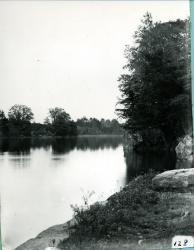
Saco River narrows, Biddeford, ca. 1915
McArthur Public Library
Biddeford's coastal location and partially navigable river meant that it was noticed quite early by Europeans. Bartholomew Gosnold, Martin Pring, Sieur de Monts and Samuel de Champlain noted and mapped the area from 1602-1606. John Smith passed through in 1614. The men credited with European settlement of the area, however, were Sir Ferdinando Gorges and Richard Vines.
Gorges, an English aristocrat and member of the Plymouth Company, was determined to overcome the difficulties that had plagued the Popham Colony (Brunswick) in 1606-7. He was convinced that the climate was no less harsh than that of other thriving areas in the Old World, and commenced to prove it by arranging his own experimental colony.

Champlain's map of Saco Bay and the Saco River, 1605
McArthur Public Library
Gorges engaged his friend Richard Vines to lead a settlement over the winter of 1616-1617, specifically to prove that the climate was habitable. Vines and the colonists settled at the protected area at the mouth of the Saco River, and called it Winter Harbor. They traveled up river and spent time among the native villages, where they were treated with kindness and generosity. Not much detail is known about that first winter, except that it was a success and led to further settlement of the area.

Saco River narrows, from the Biddeford side, 1911
McArthur Public Library
Over the next few years, the Plymouth Company became the Council of Plymouth. The Council granted large tracts of land to various gentlemen, including a tract along the western banks of the "Swanckadocke" River to Richard Vines and John Oldham, "containing in breadth by the sea four miles, and eight miles up to the mainland." The interior lands were referred to at that time as east or west Saco--after their orientation to the river. The use of these names continued for the next hundred years or so. Vines took possession of the tract June 5, 1630 in a ceremony witnessed by six fellow travelers and explorers. During these early years about 40 settlers were living in the area; the patentees were obligated to recruit 50 settlers within 7 years to fulfill their contractual duties.